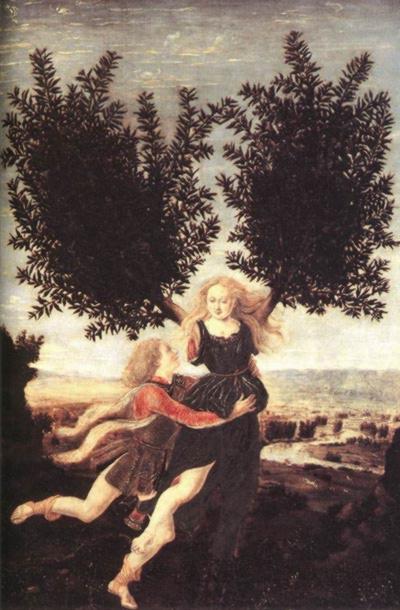We've a farspread chess iconography in 14th century. 16 figures, the pawns are presented by professions. This model is very stable and is still living in ca. 1480, for instance in Germany.
That's a chess-pawn, a presentation of a profession.
We've a French text, the "echecs amoureux", a poem (anonymous author) ca. 1370
This was enlarged ca. 1398 by Evrart de Conty to a sort of encyclopedia, where he treats the spheres, the Muses, the artes and a lot of stuff. In the final scene of this book the author plays with a women the game of chess. Both have allegoric pieces of chess, somehow figures of the Roman de la Rose. The man has 16 pieces, the woman has 16 other pieces. And there is a series with 16 gods - how these refered to the 16 pieces of chess, stayed a riddle, at least to us.
These gods have been later (in 15th century) iconographically presented in the text, at least there are three versions with pictures.
The god Mars
In 1418 Poggio Bracciolini, a secretary of popes and writer of a lot of stuff, came together with the new pope Martin from Constance, visiting first Milan and Filippo Maria Visconti. In Constance he used his time to detect writings and manuscripts, which were north of the Alps and unknown in Italy. Beside others he found a text of Manilius, in which Manilius reported about the system of the 12 Olympian gods and combined them with a system of the zodiac. It's not reported, if Filippo Maria Visconti got his nose on this object, but its plausible, as the work of Poggio was variously discussed.
Between 1418 - 1425 Filippo Maria Visconti then commissioned the
Michelino Tarot. It contained 16 gods as the chess-version of Edvart da Conty, but it differed in the figures. It contained the 12 Olympian gods as the the Manilius text and they formed the 12 highest trumps. But Filippo Maria added figures, partly from the Trionfi of Petrarca and partly from Petrarca's interpretation of Ovid's Metamorphoses.
http://trionfi.com/0/b/71/
(the motif of Daphne was chosen by the descendant of Filippo Maria, Galeazzo Maria to present himself and his bride Bona of Savoyen; the figure of Daphne appears in the deck)
In 1441 (likely) we have the Cary-Yale and it has 16 cards per suit. From his trump-series 11 trumps survived. It's possible (better likely), that this deck had 16 trumps and that these were arranged according a sophisticated chess-interpretation.
In ca. 1463 (likely) we've another deck surviving, the Charles VI. More or less only the trump series survived. It was shown, that this might be a complete trump version.
A 22-special-cards version of Trionfi card till this date can't be proven. We know, that another version of Trionfi decks was used, that likely had 5x14 cards. There are three pieces of evidence for it, the note of 1.1.1441, the 14 trumps of the Bembo deck and the note 1457 in Ferrara.
In 1469 the Palazzo-Schifanoia pictures were started. They were made according the order of Manilius.
Chess were used - at least in Germany - ca. 1470 contemporary as a motif in literature about good marriage - the right side shows the bad example. This use had similar aspects as the trionfi cards, which also played an erotical role.






